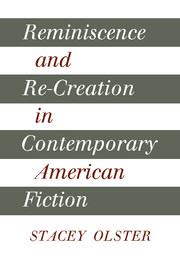Book contents
- Frontmatter
- Contents
- Preface
- Key to Abbreviations
- Reminiscence and Re-Creation in Contemporary American Fiction
- Introduction
- 1 A Disruption of Sensibility
- 2 The Transition to Post-Modernism: Norman Mailer and a New Frontier in Fiction
- 3 Thomas Pynchon: An Interface of History and Science
- 4 John Barth: Clio as Kin to Calliope
- Conclusion: “Subjective Historicism”
- Notes
- Bibliography
- Index
- PERMISSIONS
3 - Thomas Pynchon: An Interface of History and Science
Published online by Cambridge University Press: 19 March 2010
- Frontmatter
- Contents
- Preface
- Key to Abbreviations
- Reminiscence and Re-Creation in Contemporary American Fiction
- Introduction
- 1 A Disruption of Sensibility
- 2 The Transition to Post-Modernism: Norman Mailer and a New Frontier in Fiction
- 3 Thomas Pynchon: An Interface of History and Science
- 4 John Barth: Clio as Kin to Calliope
- Conclusion: “Subjective Historicism”
- Notes
- Bibliography
- Index
- PERMISSIONS
Summary
As soon as a man is wonted to look beyond surfaces, and to see how this high will prevails without an exception or an interval, he settles himself into serenity. He can already rely on the laws of gravity, that every stone will fall where it is due; the good globe is faithful, and carries us securely through the celestial spaces, anxious or resigned, we need not interfere to help it on … and we need not assist the administration of the universe.
–Ralph Waldo Emerson, “New England Reformers” (1844)Where the devil was heaven? Was it up? Down? There was no up or down in a finite but expanding universe in which even the vast, burning, dazzling, majestic sun was in a state of progressive decay that would eventually destroy the earth too.
-Joseph Heller, Catch-22 (1961)At first glance, it may seem odd to consider the historical perspective of Thomas Pynchon after examining that of Norman Mailer. Whereas Mailer came to appreciate scientific processes only late in his career, Pynchon has shown a delight in them all along. But the two authors share more in common than initially might be suspected. “[T]here are three possibilities of Being, “Mailer once posited.” There is Culture when one exists in a milieu, when one's life is obedient to a style – the peasant in his village lives in Culture like bacteria in a petri dish. There is History, the highest form of life; it has the turns and starts, the surprises, the speed of change and the fires of courage an animal knows on a long trip for food. And there is Chance.
- Type
- Chapter
- Information
- Publisher: Cambridge University PressPrint publication year: 1989



